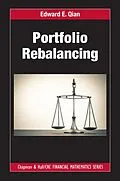The goal of Portfolio Rebalancing is to provide mathematical and empirical analysis of the effects of portfolio rebalancing on portfolio returns and risks. The mathematical analysis answers the question of when and why fixed-weight portfolios might outperform buy-and-hold portfolios based on volatilities and returns. The empirical analysis, aided by mathematical insights, will examine the effects of portfolio rebalancing in capital markets for asset allocation portfolios and portfolios of stocks, bonds, and commodities.
Autorentext
Edward Qian is a Chief Investment Officer with PanAgora Asset Management. He has research experience and expertise in quantitative investing, portfolio theory, and asset allocation. He is the co-author of the bestselling book, Quantitative Equity Portfolio Management: Modern Techniques and Applications.
Klappentext
The goal of Portfolio Rebalancing is to provide mathematical and empirical analysis of the effects of portfolio rebalancing on portfolio returns and risks. The mathematical analysis answers the question of when and why fixed-weight portfolios might outperform buy-and-hold portfolios based on volatilities and returns. The empirical analysis, aided by mathematical insights, will examine the effects of portfolio rebalancing in capital markets for asset allocation portfolios and portfolios of stocks, bonds, and commodities.
Inhalt
TABLE OF CONTENTS
Preface
1. Introduction
1.1 Risk Management
1.2 Rebalancing Alpha
1.3 Diversification Return, Volatility Effect
1.4 Serial Correlation and Rebalancing Alpha
1.5 New Topics in Portfolio Rebalancing
1.6 Outline of the Book
2. A Brief Review of Portfolio Theory
2.1 Arithmetic and Geometric Means
2.2 Return Volatilities
2.3 Relationships between Arithmetic and Geometric Means
2.4 Portfolio Return and Volatility
2.5 Serial Correlation and Volatility of Multi-Period Returns
3. Portfolio Rebalancing
3.1 Simple Examples
3.2 Rebalancing Long-Only Portfolios
3.3 Rebalancing Long-Short Portfolios
3.4 Rebalancing Alpha
4. Volatility Effect and Return Effect
4.1 Definitions of Two Effects
4.2 Positive Return Effect of Long-Only Portfolios
4.3 Positive Volatility Effect of Long-Only Portfolios
4.4 Cases of Positive and Negative Rebalancing Alphas
4.5 Two-Asset Long-Short Portfolios
5. Analysis of Volatility Effect
5.1"Diversification Return"
5.2 Maximizing "Diversification Return"
5.3 Diversification Returns of Long-Short Portfolios
6. Analysis of Return Effect
6.1 Return Effect of Long-Only Portfolios
6.2 The Impact of Cross-Sectional Serial Correlations on Return Effect
6.3 Approximating Return Effects of Long-Short Portfolios
7. Analysis of Rebalancing Alpha
7.1 Rebalancing Alpha of Two-Asset Portfolios
7.2 Rebalancing Alpha of General Portfolios
8. Asset Allocation Portfolios
8.1 Traditional 60/40 portfolios
8.2 Risk Parity portfolios
9. ASSET CLASS PORTFOLIOS
9.1 Stock portfolios
9.2 Bond portfolios
9.3 Commodity portfolios
10. Rebalancing Alpha and Mean Reversion
10.1 Two-Asset Two-Period Case
10.2 Multiple-Asset Two-Period Case
10.3 Two-Asset Three-Period Case
10.4 Multiple-Asset Three-Period Case
10.5 The General Case
10.6 Incomplete Rebalance
11. Risk and Return of Rebalancing Effects
11.1 Terminal Wealth
11.2 Expected Terminal Wealth
11.3 Variance of Terminal Wealth
11.4 Comparison of Two Variances
11.5 A General Two-Asset Case
11.6 The Impact of Serial Correlations
11.7 Terminal Wealth of Long-Short Portfolio
12. Threshold Rebalancing
12.1 Return dispersion or weight dispersion as a threshold
12.2 Numerical simulation of threshold rebalancing
